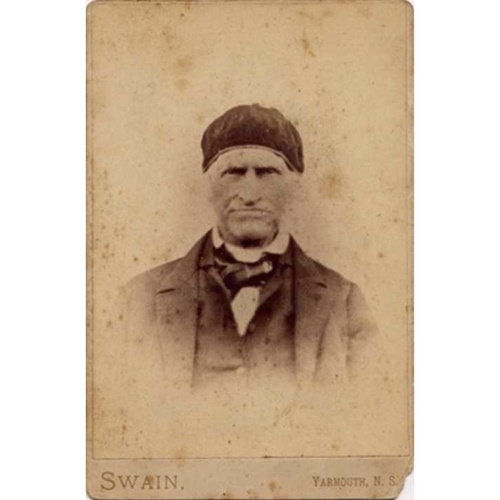
Source: Courtesy of Wikimedia Commons
ENTREMONT, SIMON D’, agriculturist, politician, and office-holder; b. 28 Oct. 1788 at West Pubnico, N.S., third child of Bénoni d’Entremont* and Anne-Marguerite Pothier; d. 6 Sept. 1886 at East Pubnico, N.S.
Philippe Mius* d’Entremont, lieutenant to Charles de Saint-Étienne* de La Tour, the governor of Acadia, was granted the barony of Pobomcoup; near Cape Sable, by the latter in 1651 or 1653. During the expulsion of the Acadians by Governor Charles Lawrence*, Simon d’Entremont’s father was driven out of Pobomcoup some time between 1756 and 1758; he was one of the first to return to this region, settling at West Pubnico around 1766.
According to George Stayley Brown, Simon d’Entremont did not go to school, there being none at the time, but he nevertheless managed to learn to express himself in writing in both French and English and to acquire the rudiments of Latin and Micmac. On 20 June 1810 Simon married Elizabeth Larkin, of East Pubnico. He then took up residence on the east side of Pubnico harbour, where he had received quite a large piece of property from his father. Nine children were born of the marriage. His first wife died on 16 Feb. 1830, and the next year he married Élisabeth Thériault, of Meteghan, N.S.; they also had nine children.
In the provincial elections of 1836, Simon d’Entremont stood for Argyle Township, established as a constituency that year. The population of this township in Yarmouth County was largely Acadian. D’Entremont won the election and, according to Clarence J. d’Entremont, he and Frederick Armand Robicheau, of Corberrie in Digby County, were the first Acadians in North America elected to a house of assembly.
In 1823 the Legislative Assembly of Nova Scotia passed a resolution permitting Catholics who were elected members to assume their seats without taking the oaths under the Test Act, which denied tenets of the Roman Catholic faith. However, tradition has it that at the opening of the 15th session on 31 Jan. 1837, when Simon d’Entremont stepped forward to take his place, the test oath apparently was brought to him. After reading it, he said: “You can take back your document . . . . I would rather swallow a dogfish, tail first, than swear that.” Moreover, he well knew that he was right to refuse to take the oath, for it had been abolished eight years earlier by the British parliament. Simon d’Entremont was allowed to take his seat after swearing a simple oath of loyalty to the laws of the land. He sat from 1837 until dissolution in 1840.
D’Entremont stood again in the 1840 elections but was defeated by John Ryder of Argyle; he then withdrew from the political arena but not from public life. Two years earlier, in 1838, he had been appointed a justice of the peace for Yarmouth County, and he held this office to an advanced age. He had also been appointed supervisor of sewers in Canton Township in 1839. From 1854 to 1864 he was customs officer for the ports of Argyle.
D’Entremont ended his long career in public service on 6 Sept. 1886. Four days later the parish priest of West Pubnico, Father William McLeod, noted: “I have today inhumed Simon d’Entremont, Esq. with all the rites of the Church he served so well. He had a large funeral, attended by many English-speaking families.” He left 136 descendants – children, grandchildren, and great-grandchildren.
Arch. paroissiales, Saint-Pierre (Pubnico-Ouest, N.-É.), Reg. des baptêmes, mariages et sépultures, 10 sept. 1886. Centre acadien, Collège Sainte-Anne (Church Point, N.-É.), Paroisse Sainte-Marie (Meteghan, N.-É.), Reg. des baptêmes, mariages et sépultures, 1818–29. Centre d’études acadiennes, univ. de Moncton (Moncton, N.-B.), Fonds Placide Gaudet, “Notes généalogiques sur les familles acadiennes, c.1600–1900” (mfm. at the Centre acadien, Church Point). Le Moniteur acadien (Shédiac, N.-B.), 16 sept. 1886. Directory of N.S. MLAs, 90. G. S. Brown, Yarmouth, Nova Scotia: a sequel to Campbell’s history (Boston, 1888), 482. H. L. d’Entremont, The baronnie de Pombcoup and the Acadians: a history of the ancient “Department of Cape Sable,” now known as Yarmouth and Shelburne counties, Nova Scotia (Yarmouth, N.S., 1931), 54. C. J. d’Entremont, “À la mémoire de Simon d’Entremont,” Le Petit Courrier (Pubnico-Ouest), 9 mars 1967; “Simon d’Entremont de Pubnico-Est, 1788–1886 . . . ,” Soc. hist. acadienne, Cahiers (Moncton), 2 (1966–68): 233–35.
Cite This Article
Louis R. Comeau, “ENTREMONT, SIMON D’,” in Dictionary of Canadian Biography, vol. 11, University of Toronto/Université Laval, 2003–, accessed April 8, 2025, https://www.biographi.ca/en/bio/entremont_simon_d_11E.html.
The citation above shows the format for footnotes and endnotes according to the Chicago manual of style (16th edition). Information to be used in other citation formats:
| Permalink: | https://www.biographi.ca/en/bio/entremont_simon_d_11E.html |
| Author of Article: | Louis R. Comeau |
| Title of Article: | ENTREMONT, SIMON D’ |
| Publication Name: | Dictionary of Canadian Biography, vol. 11 |
| Publisher: | University of Toronto/Université Laval |
| Year of revision: | 1982 |
| Access Date: | April 8, 2025 |



